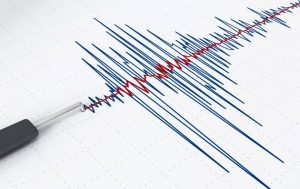
Wastewater created during oil and gas production and disposed of by deep injection into underlying rock layers is the probable cause for a surge in earthquakes in southern Kansas since 2013, a new report in the Bulletin of the Seismological Society of America concludes.
Until 2013, earthquakes were nearly unheard of in Harper and Sumner counties, the site of recent intensive oil and gas production. But between 2013 and 2016, 127 earthquakes of magnitude 3 or greater occurred in Kansas, with 115 of them taking place in Harper and Sumner counties. Prior to 1973, there were no felt earthquakes reported in the area, and only one magnitude 2.0 earthquake between 1973 and 2012.
Using data collected by a network of seismic stations installed by the U.S. Geological Survey, lead researcher Justin Rubinstein and his colleagues analyzed 6,845 earthquakes that occurred in the counties between March 2014 and December 2016.
They found that the dramatic uptick in seismicity correlated in time and location with increases in wastewater disposal that began in 2012 — and that decreases in seismicity during that time also corresponded to decreases in disposal rates.
Between 1974 and 2012, there were no magnitude 4 or greater earthquakes in the study area. Between 2012 and 2016, six such earthquakes occurred. “The probability of this rate change occurring randomly is approximately 0.16%,” Rubinstein and colleagues write in the BSSA study.
Kansas had the second-highest statewide earthquake rate in the central United States between 2013 and 2016, coming in behind Oklahoma, where a similar dramatic increase in seismicity also has been linked to wastewater injection.
In the southern Kansas study area, wastewater injection decreased significantly in 2015, falling from an average of 5 million barrels a month from July to December 2014 to 3.8 million barrels per month in March 2015. This decrease was likely due in part to a drop in oil and gas production as the prices for those commodities dropped, the researchers said, noting that the price of a barrel of oil fell by half between August 2014 and January 2015.
During the same time, the Kansas Corporation Commission developed rules to limit wastewater injection in the study area, with the rules going into full effect in July 2015. Since then, wastewater injection in the study area has dropped by almost 50 percent.
There is a corresponding decrease in seismicity in 2015, but Rubinstein said it is difficult to tell how much economic shifts or new regulation contributed to that trend. “We can’t fully disentangle it. But there’s no question that economics plays a role here because injection started to drop off before the new rules went into place. ”
“It certainly seems probable that regulations have an effect,” he said, “but we would need to speak to individual [oil and gas] operators to determine the extent of that effect.”
The researchers say that fluids injected into the crystalline rock basement below the Kansas oil and gas sites increased pressures in the rock pores and reduced friction along faults to trigger these induced earthquakes. Not all wastewater injection disposal sites have earthquakes associated with them, Rubinstein noted. In some cases, the fluid pressures may not be able to get to depths where earthquakes occur, or there may be some places in the rock basement that are more susceptible than others to fluid effects.
It’s also difficult to know how long these stresses might continue to produce earthquakes, he added. Seismicity related to an injection well in Youngstown, Ohio in 2013 lasted only a few weeks, while fluid injection at Rocky Mountain Arsenal in Colorado stopped in 1966 but significant seismicity continued in the area until the 1980s.
“It’s hard to say how long it’s going to last given that what we’re looking at in Kansas is a much higher rate of injection than in the places where seismicity slowed quickly, and many, many more wells,” said Rubinstein. “If they shut off all the injection, the decay could still take years, just because there’s been such a dramatic change in the regional pressure field.”
Rubinstein will continue to work in Kansas to learn more about whether seismologists can consistently see foreshocks and earthquake swarms in the seismic record. “We have an incredible network there, and one of the best documented cases of induced seismicity with publicly available seismic data,” he said.
Reference:
Justin L. Rubinstein, William L. Ellsworth, Sara L. Dougherty. The 2013–2016 Induced Earthquakes in Harper and Sumner Counties, Southern Kansas. Bulletin of the Seismological Society of America, 2018; DOI: 10.1785/0120170209
Note: The above post is reprinted from materials provided by Seismological Society of America.










